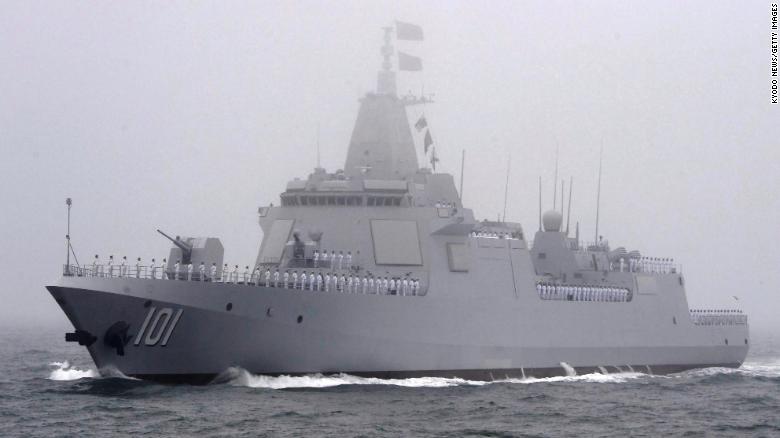By Carl Schuster
 Carl Schuster is a retired US Navy captain, a former director of operations at the US Pacific Command's Joint Intelligence Center, a current Hawaii Pacific University instructor and a part-time defense consultant. he opinions expressed in this commentary are solely his own.
Carl Schuster is a retired US Navy captain, a former director of operations at the US Pacific Command's Joint Intelligence Center, a current Hawaii Pacific University instructor and a part-time defense consultant. he opinions expressed in this commentary are solely his own.
Newport, Rhode Island (CNN)It's no secret that China's navy has experienced unprecedented growth, rapid modernization and an expanded range of operations over the past 15 years -- and this has raised concerns about the country's ultimate intentions.
At a conference earlier this month, more than 200 naval experts gathered at the United States Naval War College to discuss these concerns and the broader challenges posed by China's expanded naval power.
One expert, the US Pacific Fleet's former intelligence chief, retired Navy Capt. James Fanell noted that China's People's Liberation Army Navy, or PLAN for short, has commissioned nearly four times as many ships as the US Navy over the last decade.
Another participant mentioned that the ratio of naval power in the Western Pacific has shifted in China's favor with the PLAN possessing 106 naval missile platforms in the Western Pacific versus the US Navy's 22.
Perhaps more significantly, the panels noted China claims it has made rapid progress in developing laser, hypersonic and electromagnetic pulse weapons programs and unmanned systems.
But despite its resources, China and the PLAN face challenges and shortfalls that preclude it from being the threat these advances might suggest.
One big problem: China's military branches still don't work that well together, despite a strong push by President Xi Jinping that they do so and recent reforms establishing joint theater commands.
The PLA has yet to demonstrate full service integration in its exercises, suggesting much work remains to be done. Joint exercises continue to be small-scale, and the services' roles in them remain separated either physically or chronologically.
This means gaps remain in multi-service operations, particularly in operations beyond the First Island Chain or "Far Seas."
China enjoys surveillance superiority over the waters near its coast (the Near Seas) but not in the Far Seas. Its lack of sea-based air power and overseas bases to provide land-based air support limits the PLAN's capacity to project power ashore by other than land-attack cruise missiles or unmanned systems.
While the PLAN has significantly increased its overseas operations since it started anti-piracy operations 11 years ago, it has yet to demonstrate the capability to protect its sea lines of communications through the Indian Ocean, through which 70% of China's energy requirements and over 80% of its trade must pass.
It has a naval support base in Djibouti and access agreements in the region, but the PLAN's logistics train lacks the capacity to support the deployed forces required to counter a major opponent.
Nonetheless, China's maritime challenge is very real.
It has initiated a massive oceanographic research and survey effort across virtually all the world's oceans. And the PLAN does operate globally, conducting exercises with more than 30 nations and operating in all the world's oceans and four of the seven seas.
And China's marine strategy, authored by its Maritime Commerce Ministry, brings numbers to bear that no country can match, by closely integrating China's civic, commercial, diplomatic and naval operations.
For example, Chinese companies and merchant shipping constituted the first responders to Mozambique following recent typhoon devastation. The PLAN has a supporting role in that strategy, advancing China's economic and political interests.
While regional goals, including dominance of the "near seas" -- Taiwan and the South China Sea -- remain the PLAN's main focus, China's leaders are addressing the PLAN's worldwide ambitions and plan to achieve those goals before 2050.
The West's experts and intelligence community must monitor its progress closely, shedding past assumptions when assessing new information to provide decision makers the insights required to anticipate and forestall any aggressive designs that China may harbor.
Deterring conflict requires adequate force levels and clear understanding of all the parties' actions and intentions.
To this point, the West has done a poor job figuring this out and is now playing catch-up.
Capt. Fanell described it as the "US intelligence community and academia miscalculation of the scope, scale and timing of the PLAN's modernization and its impact on US national security."
China presently maintains a near global presence on the world's oceans, its fleet is growing rapidly and its intentions seem more assertive than Beijing's official statements profess. If dominating any portion of the "Far Seas" is China's goal, waiting for Beijing to achieve it before responding is not an option that assures peace.
China is employing an integrated multi-agency approach to expanding its influence in every continent. It has established economic links with countries across the world, and its Belt and Road Initiate (BRI) has both continental and maritime dimensions. Its media outlets, commercial companies, diplomats and military all have roles in Beijing's national strategy. Countering China's strategy will require a similar comprehensive diplomatic, economic and military response.
No comments:
Post a Comment